Exploring 3D Printing: Plastic and Metal Innovations
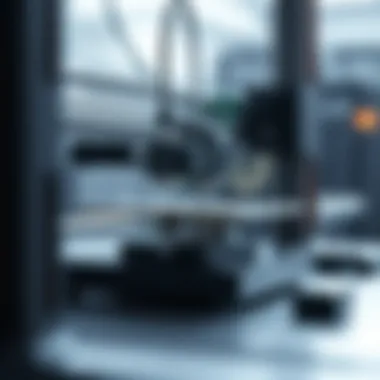

Intro
The evolution of 3D printing technology represents a seismic shift in manufacturing possibilities. As we delve into the intricate interplay between machines and materials, particularly plastics and metals, it becomes clear that this field is not just for hobbyists anymore. Companies across various sectors are leveraging 3D printers to enhance production lines, reduce waste, and innovate design processes.
This discussion aims to illuminate the various methodologies employed in the realm of 3D printing. We'll explore the nuanced capabilities of these machines, the technologies they employ, and how industries are harnessing their potential. Notably, the focus will be on how these advancements are altering the landscape of manufacturing and design.
3D printing now finds itself at the forefront of industrial change. From automotive components crafted with precision to intricate medical implants tailored to individual needs, the versatility of 3D printing is nothing short of revolutionary.
By examining the methodologies and tools that underpin the technology, we will appreciate its relevance and potential to redefine the future of production and innovate traditional practices. Throughout this article, we'll share gripping real-world applications, juxtapose new findings with past studies, and consider the broader implications in this dynamic field.
Prolusion to 3D Printing Technology
The landscape of manufacturing has undergone a seismic shift with the advent of 3D printing. This transformative technology represents more than just a method for creating objects; it epitomizes a new approach to design, production, and distribution. Across various industries—from automotive to aerospace, and healthcare to consumer goods—3D printing is being embraced for its uniqueness and versatility. Understanding the fundamentals of 3D printing technology is paramount, as it lays the groundwork to appreciate the subsequent sections covering the capabilities of 3D printers in both plastic and metal fabrication.
What is 3D Printing?
In simple terms, 3D printing, also known as additive manufacturing, is a process of creating three-dimensional objects layer by layer from a digital model. Unlike traditional subtractive manufacturing, which cuts away material, 3D printing builds up the desired form by successive addition of material. It utilizes various technologies and materials, including plastics and metals, allowing users to fabricate complex geometries that were previously unimaginable.
- Key Elements of 3D Printing:
- Digital Design: A computer-generated model is essential, typically created with CAD software.
- Layering Process: Objects are constructed one thin layer at a time, ensuring precise detailing.
- Materials Used: Options range from thermoplastics to metals, with differing properties tailored for specific applications.
The beauty of 3D printing lies in its ability to customize and refine designs easily. It facilitates rapid prototyping, enabling creators to iterate designs quickly based on feedback or changing requirements.
Historical Development of 3D Printing
Tracing back the roots of 3D printing, one finds a fascinating timeline that spans decades. The journey began in the late 1980s, where the first 3D printer invented by Charles W. Hull, known as Stereolithography (SLA), emerged. This groundbreaking machine used ultraviolet light to solidify photopolymer resin, marking the dawn of a new industrial era.
- Key Milestones in 3D Printing History:
- 1986: Charles Hull invents SLA, creating the foundation for 3D printing.
- 1992: The first commercially available 3D printer, the STL format, is introduced, increasing accessibility.
- 2000s: Development of multiple technologies, including Fused Deposition Modeling (FDM) and Selective Laser Sintering (SLS).
- 2010s: Widespread adoption in various sectors, with printers becoming more affordable for consumer use.
As 3D printing technology progressed, it began intersecting with advancements in materials science and digital fabricating techniques, further expanding its horizons. It now holds relevance not simply in industrial applications but also on a personal level with hobbyists and designers.
"3D printing is not just a technology; it is an innovation driver that reshapes our approach to manufacturing."
By diving into the world of 3D printing technology, we open the floodgates to a myriad of possibilities in plastic and metal fabrication, setting the stage for the detailed discussions in the sections that follow.
Fundamentals of 3D Printing Processes
Understanding the fundamentals of 3D printing processes is crucial, as it lays the groundwork for how materials are transformed into tangible objects. This knowledge will help the reader grasp the various techniques and technologies that facilitate 3D printing, particularly regarding plastic and metal fabrication. The principles behind additive manufacturing are not just technical jargon; they reflect a paradigm shift in how we conceive production and design. From personalized consumer goods to complex aerospace components, these processes allow for creativity to run wild, streamlining manufacturing while reducing waste.
Additive Manufacturing Principles
At the core of 3D printing is the principle of additive manufacturing, which involves layering materials to create an object. Unlike traditional subtractive manufacturing that carves away material, additive processes build an object layer by layer. This is analogous to a baker layering ingredients to form a cake, where each layer adds to the structure without removing any leftover pieces. One of the primary benefits of this approach is its ability to create intricate designs that would be nearly impossible to achieve through conventional means. For instance, lightweight lattice structures are commonplace in aerospace applications, where reducing weight without sacrificing strength is paramount.
Key Technologies Used in 3D Printing
Several key technologies underlie the 3D printing processes, each with its own strengths and limitations. Understanding these technologies is essential for identifying the right method for a given application.
Fused Deposition Modeling (FDM)
Fused Deposition Modeling, or FDM, is among the most popular methods used in 3D printing. It works by extruding molten plastic that solidifies to form layers, rather like squeezing toothpaste from a tube. The major advantage of FDM lies in its accessibility, both in terms of cost and ease of use. Many enthusiasts and small businesses utilize FDM printers due to their affordability and the wide range of materials available. However, a notable downside is that the surface finish often lacks the polish seen with other methods. Nevertheless, updates in material technology are continually improving the usability and reliability of FDM.
Stereolithography (SLA)
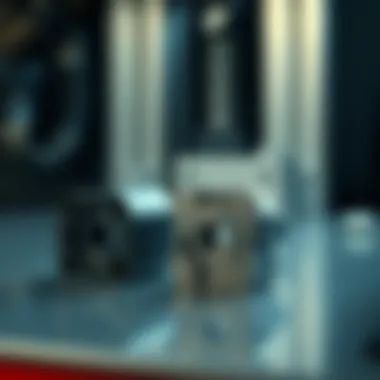
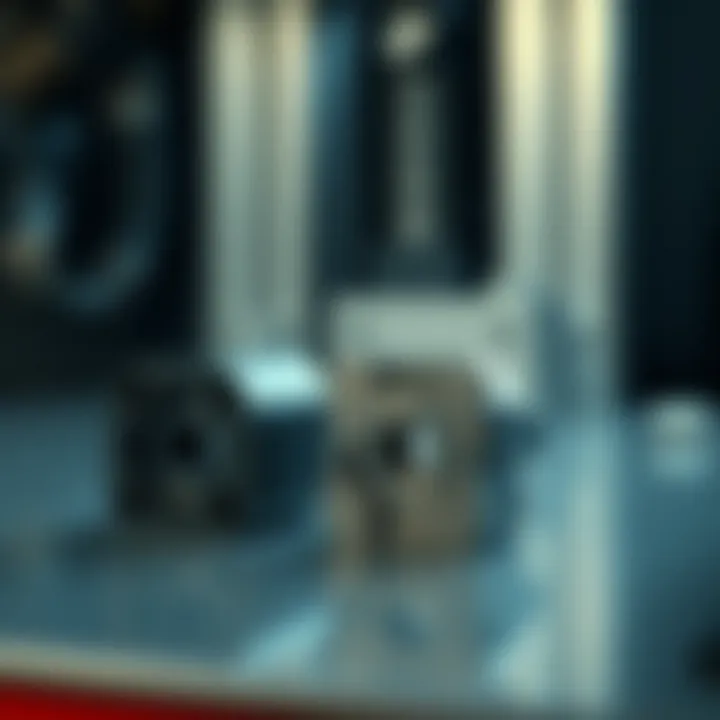
Stereolithography, or SLA, introduces a whole different ballgame in 3D printing. This process utilizes a laser to cure liquid resin into hardened plastic, layer by layer. What sets SLA apart is its precision; it can create highly detailed features with smooth finishes, making it popular for prototyping intricate designs in engineering and the arts. However, the resins can be more expensive and require specific handling and post-processing. This method shines when fine details are crucial, giving designers the freedom to explore more complex geometries.
Selective Laser Sintering (SLS)
Selective Laser Sintering uses powdered materials that a laser selectively fuses together to create a part. This allows for a wider variety of materials, including plastics and metals. SLS stands out primarily because it creates strong and functional parts that often do not require further support structures since the unused powder can support the build. One of the drawbacks, however, is that parts created this way may have a rougher surface finish compared to those made through SLA. Nonetheless, SLS is favored in industries where durable and high-strength components are necessary.
3D Printing with Plastic Materials
3D printing with plastic materials stands as a cornerstone in additive manufacturing, offering vast flexibility and an array of possibilities for designers, engineers, and hobbyists alike. Plastics are the go-to materials for many applications due to their lightweight nature and versatility in various fields. Whether it's prototyping or final production, understanding the key attributes and potential drawbacks of plastic printing is essential.
Not only does 3D printing with plastics offer rapid prototyping capabilities, but it is also highly cost-effective. The quick turn-around times can significantly reduce time-to-market, a crucial factor in today’s highly competitive industries. This section delves into the types of plastics commonly used, their advantages, and the limitations they present, providing a well-rounded view.
Common Types of Plastic Used in 3D Printing
PLA (Polylactic Acid)
PLA is often hailed as the darling of the 3D printing world. This biodegradable plastic, derived from renewable resources like cornstarch or sugarcane, has gained favor for its ease of use and minimal warping during the printing process. A significant characteristic of PLA is its low melting temperature, making it user-friendly for both novices and seasoned professionals. It's particularly popular in educational environments due to its non-toxic nature and ability to produce high-quality prints.
The unique feature of PLA lies in its aesthetic appeal—it prints with a high sheen, making it ideal for decorative items or prototypes where appearance matters. However, while PLA is advantageous, it does have limitations. Its low thermal resistance means it isn't the best choice for items exposed to heat; it can deform in warm environments.
ABS (Acrylonitrile Butadiene Styrene)
Another plastic widely used in 3D printing is ABS, known for its strength and durability. Often favored in applications that require toughness, ABS can withstand higher temperatures compared to PLA, making it suitable for functional prototypes and various manufacturing tasks. One of the standout characteristics of ABS is its ability to be easily post-processed, allowing for sanding and painting, which enhances its aesthetic value.
But, there are downsides to using ABS. It emits fumes during printing that can be quite unpleasant and potentially harmful in unventilated areas. Moreover, the likelihood of warping can pose a challenge, necessitating a heated build platform for successful prints.
Nylon
Nylon is a powerhouse when it comes to 3D printing materials. This plastic is known for its exceptional flexibility, strength, and resistance to wear, which makes it a popular choice for functional parts that will endure stress and strain. The characteristic that sets Nylon apart is its ability to absorb moisture, which can lead to varying results in print quality unless stored and handled carefully.
This unique property adds complexity but also offers significant advantages, such as post-processing opportunities that may enhance mechanical properties. However, the moisture sensitivity also requires users to take extra precautions during storage and printing, posing a notable challenge to some.
Advantages of Plastic 3D Printing
3D printing with plastics brings several key advantages. Firstly, the material options allow for a broad range of applications, from intricate designs to rugged components. The ingenuity of design cannot be overstated, as plastic structures can be lightweight yet sturdy, channeling innovation in countless industries. Additionally, the relatively low cost of these materials compared to metals further encourages experimentation and development.
Limitations of Plastic 3D Printing
Despite its many strengths, plastic 3D printing is not without drawbacks. One major limitation is the temperature sensitivity; certain parts can’t endure extreme heat. Additionally, the longevity of plastic objects can be an issue, especially when compared to metal counterparts which provide higher durability. Furthermore, issues like warping and stringing during the printing process can challenge novice users.
In summary, while plastics play a pivotal role in the world of 3D printing, understanding both their strengths and weaknesses is crucial for maximizing their potential in manufacturing.
3D Printing with Metal Materials
The significance of using metal materials in 3D printing cannot be overstated, especially in an age where precision, strength, and durability are paramount. This section will examine the specific types of metals suitable for printing, delve into the inherent benefits of metal 3D printing, and address the challenges that come along with this sophisticated technology.
Types of Metal Suitable for 3D Printing
Stainless Steel
Stainless steel, known for its resistance to corrosion and rust, is a standout choice for 3D printing. Its key characteristic lies in its strength-to-weight ratio. This metal's ability to withstand high stress and temperature makes it ideal for applications in industries such as aerospace and medical devices.
One unique feature of stainless steel is its versatility in manufacturing complex geometries that traditional methods may struggle with. One disadvantage to note is that while it is durable, it tends to be heavier compared to other materials, which may not suit all applications. Nevertheless, the benefits often outweigh this drawback, making stainless steel a go-to for many metal fabrication projects.
Titanium
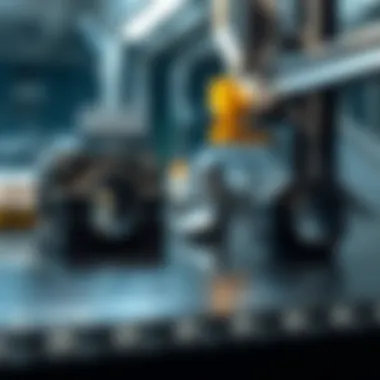
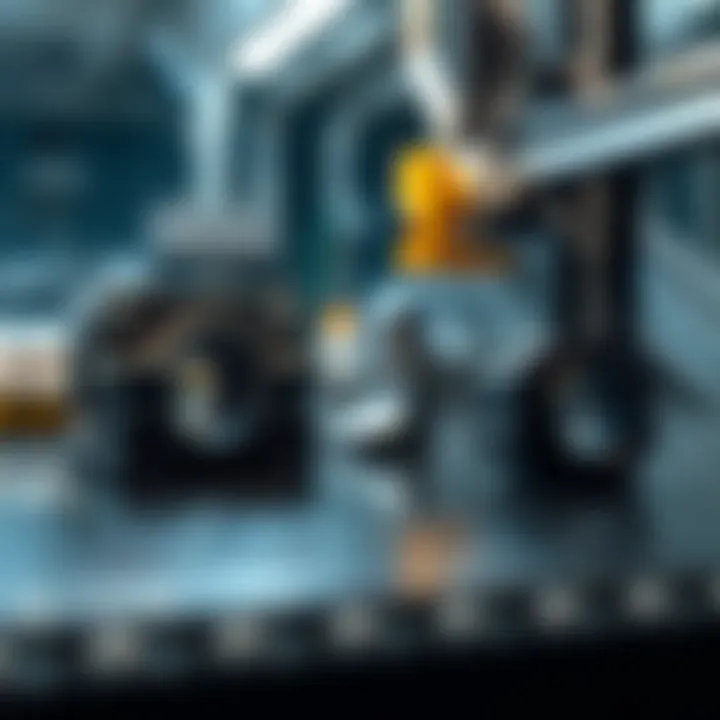
Titanium is often revered in engineering fields for its exceptional strength and lightweight nature. Its outstanding corrosion resistance is a critical factor that contributes to its widespread use, particularly in aerospace and automotive sectors where performance is non-negotiable.
A unique aspect of titanium is its biocompatibility, allowing it to be used extensively in medical implants and prosthetics. However, working with titanium can present challenges—it requires specialized equipment and expertise, making it a costly option. Even so, its benefits for high-performance applications justify the investment for many manufacturers.
Aluminum
Aluminum's allure in the realm of 3D printing primarily stems from its lightweight properties and decent strength. This metal is often used in transportation applications due to its ability to reduce overall weight without compromising structural integrity. Furthermore, aluminum has a natural ability to dissipate heat rapidly.
One of the primary advantages of aluminum is its cost-effectiveness compared to other metals, making it accessible for various applications ranging from consumer goods to industrial components. Nevertheless, aluminum can be less robust in high-stress environments than stainless steel or titanium, posing limitations for some advanced engineering applications.
Benefits of Metal 3D Printing
Metal 3D printing offers remarkable benefits that traditional manufacturing processes cannot match. One of the most significant advantages is design freedom; it allows for intricate designs and geometries that are challenging to achieve using conventional methods. Additionally, the technology reduces waste, as it employs an additive manufacturing process. This efficiency not only saves materials but also contributes positively to environmental sustainability.
Moreover, metal 3D printing accelerates product development cycles. Rapid prototyping capabilities allow for faster iterations, which is critical in competitive industries—giving companies an edge in time-to-market. Importantly, the technique supports on-demand manufacturing, minimizing the need for excessive inventory.
Challenges in Metal 3D Printing
Despite its advantages, metal 3D printing is not without challenges. One of the key difficulties lies in the cost of equipment and materials. High-quality metal powders required for printing can be significantly more expensive than plastic materials. Furthermore, the initial investment in specialized machinery often leads to high operating costs.
Another notable challenge is the complexity of post-processing. After printing, metal parts often require additional steps such as heat treatment or machining to enhance strength and finish, adding time and labor costs to projects. Ensuring the accuracy of these processes can be critical to achieving the desired properties in the finished product.
Comparison of Plastic and Metal 3D Printing
The realm of 3D printing is vast and ever-evolving, yet the distinction between plastic and metal printing stands out as a critical comparison. One must consider various elements, benefits, and implications of each method. This exploration is not just an academic exercise but a practical need for industries aiming to innovate and enhance production capabilities.
Material Strength and Durability
When weighing plastic against metal in the 3D printing sphere, material strength and durability come into play in a substantial way. Metal parts often demonstrate higher tensile strength, making them suitable for applications where the product will endure critical load or stress. On the other hand, plastics may exhibit flexibility and resilience that serve well in various consumer products but tend to falter when faced with high-stress scenarios. For instance, metal components can withstand harsher environments, while plastics can be advantageous in making lightweight prototypes or products that don’t bear excessive loads.
- Metal prints, especially those produced using techniques like SLS, generally deliver parts that can endure wear and tear over time.
- Plastics, like nylon, carve out a niche in multi-component designs due to their ability to join easily with other materials.
In summary, an understanding of specific use-case needs is vital when navigating the options between plastic and metal.
Cost Efficiency and Material Usage
Cost efficiency inevitably factors into any analysis of manufacturing methods, and 3D printing is no exception. On the surface, plastic materials appear to be the more economical choice. PLA and ABS filaments are typically cheaper and easier to print, making them suitable for rapid prototyping. However, the cost equation becomes murkier when long-term performance, waste, and material usage are considered.
- Metal printing may involve a higher upfront investment but can lead to savings by creating parts with intricate designs that reduce the number of necessary components.
- Weight reduction in metal designs can also equate to cost savings in shipping and materials down the line.
A nuanced understanding of both material types' costs leads to better decision-making in production environments, considering both short-term and long-term expenses.
Application Domains
Aerospace
In the aerospace sector, precision and reliability are non-negotiable. The unique properties of metal 3D printing make it a cornerstone in this field. Typically, parts like engine components, brackets, and other essential structures benefit greatly from the strength and heat resistance of titanium and aluminum. Aerospace designs must shave off every unnecessary gram to enhance fuel efficiency, making lightweight materials a critical choice. However, these benefits come with rigorous certification requirements, which can be a hurdle in the application process.
Automotive
The automotive industry, too, reaps the rewards of both plastic and metal 3D printing. Metal parts support durability in engine components while delivering lighter weight options for chasses. Styles like ABS are exploited for aesthetic components such as dashboards and housings. 3D printing allows rapid prototyping in automotive design, significantly reducing the time to market. Customized parts for high-performance vehicles add another layer of complexity but also showcase the versatility of the medium. Yet, the challenge remains in scaling these operations for mass production without sacrificing cost or quality.
Medical Devices
In the realm of medical devices, both plastic and metal materials find significant applications. Biocompatibility in plastics, such as with certain types of nylon, allows for innovative designs in prosthetics and implants. Meanwhile, metal prints produce durable surgical instruments and implants. The customizability of 3D printing allows for tailored solutions in devices, which can enhance patient outcomes. Nonetheless, meeting stringent regulatory standards can be a daunting task, adding layers of complexity to the otherwise transformational technology.
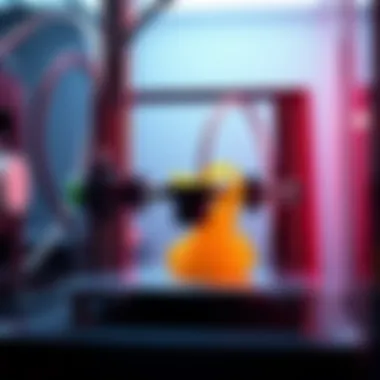
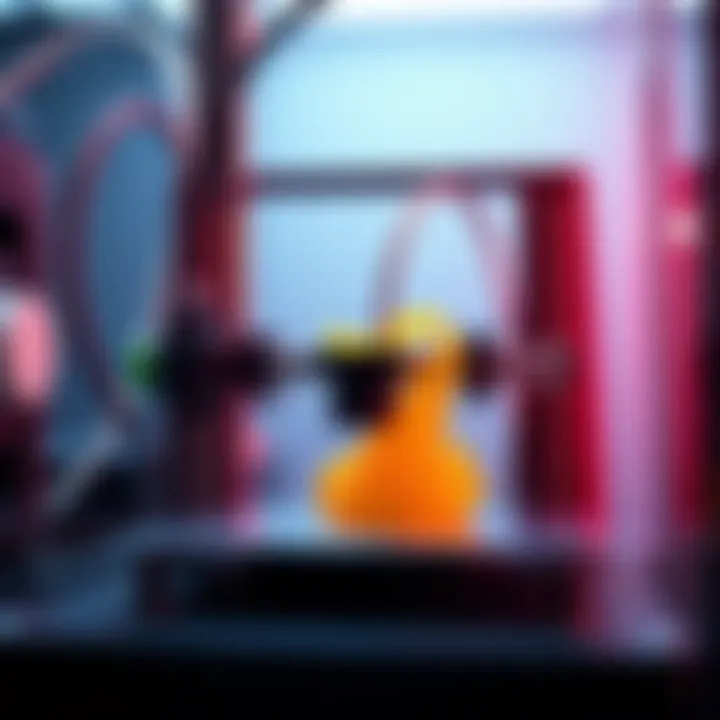
Understanding the specific attributes of each material can greatly enhance the efficiency and effectiveness of 3D printing applications across diverse fields. It emphasizes the importance of selecting the right material based on performance requirements and industry standards.
Innovations in 3D Printing Technology
The realm of 3D printing is constantly evolving, pushing boundaries faster than a rabbit on a hot skillet. Innovations in this field are not just changes in technology but represent breakthroughs that redefine how industries think about design, production, and even sustainability. In this section, we will explore some of the significant advancements that stand at the forefront of 3D printing technology, significantly impacting materials, processes, and environmental consciousness.
Advances in Material Science
Material science is at the heart of what makes 3D printing so impactful. The range of materials used has dramatically expanded, allowing for a variety of applications. For years, the plastic realm dominated, yet we have this rich tapestry of materials now available, such as composites and bio-materials. Advances like carbon fiber reinforced plastics or weather-resistant polymers have risen to prominence, offering engineers ways to create parts that not only meet but often exceed traditional manufacturing standards.
Moreover, metal 3D printing has become less of a novelty and more of a necessity in sectors like aerospace and automotive. Here, titanium and specialized alloys are common players due to their lightweight and strong characteristics. This transition not only enhances performance but also introduces more efficient methods for producing intricate designs that previously would have been thought impossible.
"Material science will dictate the future of 3D printing; its growth is what fuels our capacity to innovate."
Software and Design Improvements
The role of software in the evolution of 3D printing cannot be overstated. It is no longer sufficient to merely have robust physical machines; software now determines how well those machines can harness their capabilities. Modern slicing software has become smarter, incorporating algorithms that optimize prints for speed and material usage. This ensures that every inch of filament or powder is used judiciously, enhancing cost-effectiveness.
Additionally, the integration of Artificial Intelligence and machine learning has started creeping in. These technologies analyze vast amounts of data to help users predict failures before they happen, fine-tuning the printing process in real-time. These innovations provide designers and engineers more creative freedom while significantly reducing trial and error time.
Environmental Considerations
As more industries tap into 3D printing, the environmental repercussions of such technologies come into sharper focus. The traditional manufacturing processes can be heavy on waste; cutting parts out of large materials often leaves behind a mountain of scrap. This is where 3D printing shines with its additive approach, potentially reducing waste by as much as 90% in some instances.
In terms of energy consumption, we are seeing a trend toward the development of 3D printers that utilize renewable energy sources. Companies are beginning to investigate the use of recycled materials in their printing processes, creating a closed-loop system that minimizes the need for virgin materials. This move aligns with global sustainability goals, making 3D printing not just an engineering marvel but a considerable step toward more responsible manufacturing.
Innovations in 3D printing technology hold promising potential to redefine our relationship with both materials and the environment. The advancements in material science, software improvements, and the heightened emphasis on sustainability position 3D printing as not just a trend but a cornerstone of the manufacturing evolution henceforth.
Future Perspectives on 3D Printing
Exploring the future of 3D printing unveils a fascinating landscape filled with opportunities, challenges, and transformative capabilities. As technologies progress, 3D printing is expected to evolve beyond its current applications, impacting various industries from healthcare to aerospace. Understanding these upcoming shifts is essential for students, researchers, educators, and professionals who wish to stay ahead in their fields. With insights into emerging trends and the role of 3D printing in the context of Industry 4.0, this section aims to provide a glimpse into what the future holds for this exciting technology.
Emerging Trends and Predictions
In the next few years, the landscape of 3D printing is expected to undergo significant changes driven by technological advances and innovative applications. Here are some key trends and predictions that stand out:
- Customization and Personalization: One of the most significant trends will be a move towards mass customization. Businesses will leverage 3D printing to create tailor-made products specific to individual needs, allowing for greater consumer engagement.
- Bioprinting: The healthcare industry is likely to see breakthroughs in bioprinting, which may lead to the production of tissues or even organs. This has the potential to revolutionize transplant medicine, reducing waiting times for donors.
- Sustainability Initiatives: As concerns about environmental sustainability rise, 3D printing technologies will increasingly focus on recycling materials and reducing waste. The use of biodegradable filaments could play a pivotal role here.
- Automation and AI: Integration of artificial intelligence with 3D printers will enhance automation processes. This includes predictive maintenance, which will improve efficiency and reduce downtime.
Closure
The importance of understanding the capabilities of 3D printers in the realm of plastic and metal fabrication cannot be overstated. This article has peeled back the layers on how these machines operate, focusing on both their technical prowess and practical applications. 3D printing is not merely a technological novelty; it represents a fundamental shift in how we conceptualize and execute manufacturing processes.
3D printing provides several key benefits:
- Customization: Tailor products to meet specific needs. Whether in the automotive or medical field, this technology allows for unique designs that traditional manufacturing cannot offer easily.
- Cost Efficiency: It demands less material waste. Only the required amount of material is used, making it easier on budgets and the environment.
- Speed of Production: Prototyping and production times are significantly reduced, paving the way for faster innovation cycles.
However, considerations should also be made regarding limitations and challenges. Each process, be it plastic or metal, comes with its own set of hurdles, from material compatibility to the intricacies of design software. Therefore, familiarity with these challenges is crucial for practitioners in the field.
Overall, the impact of 3D printing on modern fabrication cannot be dismissed, with implications that extend into every sector it touches, urging students, researchers, and industry professionals alike to embrace this evolving landscape.
Summary of Key Points
- Broad Applications: 3D printers serve various industries, from aerospace to healthcare, each finding different uses based on material capabilities.
- Material Variety: Both plastic and metal have distinct characteristics, making them suitable for different applications.
- Innovation and Future Trends: Skills in handling 3D technologies are increasingly vital in today’s job market. Technologies continue evolving, presenting new challenges and opportunities.
- Interdisciplinary Synergy: The intersection of 3D printing with areas like material science propels ongoing innovation.
Final Thoughts on the Future of 3D Printing
Looking ahead, the future of 3D printing appears promising, yet fraught with complexities. As industries continue to adjust to newer methodologies, staying ahead of the curve is imperative. The integration of 3D printing technology into Industry 4.0 represents a substantial leap forward, with intelligent automation and data analytics paving the path for smart factories.
Moreover, sustainability concerns will elevate the demand for eco-friendly materials and processes to ensure the longevity of 3D printing practices. The reconciliation of efficiency with environmental responsibility is becoming a focal point in future research.
In summary, 3D printing is more than just a fleeting trend; it is a transformative force reshaping manufacturing paradigms. As advancements continue to emerge, professionals in the field must equip themselves with the knowledge and tools to navigate this rapidly evolving landscape. By fostering innovation and addressing technologies' challenges today, the future's framework can be built on solid ground.



